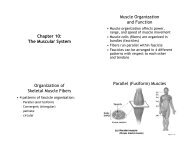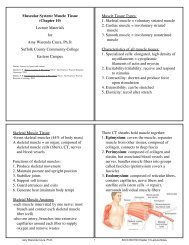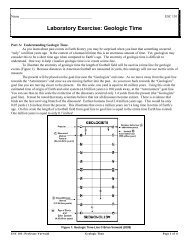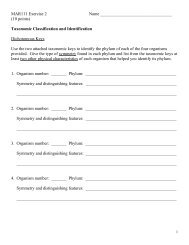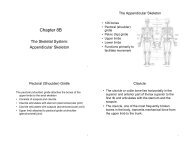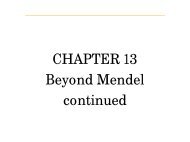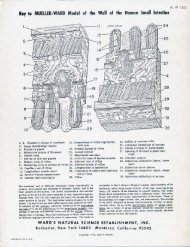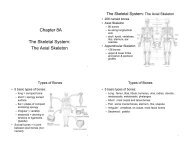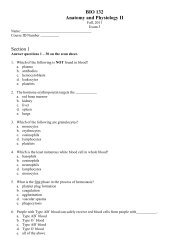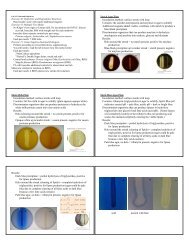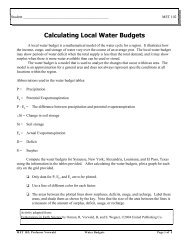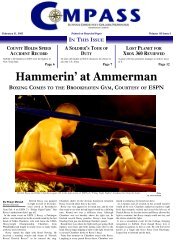The Eukaryotes: Fungi, Algae, & Protozoa - Suffolk Community ...
The Eukaryotes: Fungi, Algae, & Protozoa - Suffolk Community ...
The Eukaryotes: Fungi, Algae, & Protozoa - Suffolk Community ...
You also want an ePaper? Increase the reach of your titles
YUMPU automatically turns print PDFs into web optimized ePapers that Google loves.
<strong>The</strong> <strong>Eukaryotes</strong>: <strong>Fungi</strong>, <strong>Algae</strong>, & <strong>Protozoa</strong>(Chapter 12)Lecture MaterialsforAmy Warenda Czura, Ph.D.<strong>Suffolk</strong> County <strong>Community</strong> CollegePrimary Source for figures and content:Eastern CampusTortora, G.J. Microbiology An Introduction 8th, 9th, 10th ed. San Francisco: PearsonBenjamin Cummings, 2004, 2007, 2010.-50% of world population infected witheukaryotic pathogensTwo microbial kingdoms:1. <strong>Fungi</strong>2. ProtistaSubkingdomsA. <strong>Protozoa</strong> (animal-like)B. <strong>Algae</strong> (plant-like)Kingdom <strong>Fungi</strong>mycology = study of fungicommon characteristics of fungi:1. all are chemoheterotrophs2. most are saprophytes3. most are aerobic or facultatively anaerobic4. few are human pathogens5. cell walls are composed of chitinOrganized into three general groups based onshape:1. Molds and Fleshy <strong>Fungi</strong>-consist of long filaments of cells joined endto end = hyphae-hyphae can be one of two structural types(genetically determined for a particularfungus):1. Septate Hyphae-joined cells have distinct separationscalled septa2. Coenocytic Hyphae-hypahe consists of fused cells-hyphae grow by extension at the tip-a mass of hyphae is called a mycelium-a mold mycelium will produce two differentversions of its hyphae:1. vegetative hyphae-grow flat along surfaces-used to obtain nutrients2. aerial hyphae-stick up off the mycelium-used to produce sporesfor reproductionAmy Warenda Czura, Ph.D. 1 SCCC BIO244 Chapter 12 Lecture Notes
2. Yeasts-nonfilamentous, unicellular, ovaloid-all are facultative anaerobes-in absence of oxygen will fermentcarbohydrates into alcohol & carbondioxideA. Budding Yeasts-divide by producingoutgrowth called a bud-bud will enlarge and separate from mothercell following mitosisB. Fission Yeasts-divide by mother cell elongating andundergoing mitosis-daughter cells separated by formation of asepta in the center (fission)3. Dimorphic <strong>Fungi</strong>-can grow in multicellular mold-like hyphalform or unicellular yeast-like ovaloid formdepending on conditions-if bud fails to separate = pseudohyphae(not true hyphae like molds:hyphae = cells tightly attached by sharedwalls, cytoplasm joined by porespseudohyphae = daughters remain stuckbut no shared walls or cytoplasm)e.g. Candida albicans25°C, acid pH = yeast37°C, neutral pH = hyphaeLife cycle of fungi-fungi can reproduce asexually by:1. fragmentation of hyphae (mold),budding (budding yeast) or fission(fission yeast)2. asexual spores-fungi can reproduce sexually by theformation of sporesspores are formed on the ends of aerial hyphae(not endospores: reproductive, outside cell)-asexual spores:-form on the hyphae of one organism-germinate to form exact clones of theparent-sexual spores:-form after the fusion of two haploidnuclei from opposite mating typecells of the same species-when spore geminates it hascharacteristics of both parents-sexual reproduction is NOT common in fungiAsexual Spores-produced by mitosis and cell division-contain DNA that is exact copy of parent1. Sporangiospore-spores form in sac called sporangium-sporangium forms at end of aerial hyphaecalled a sporangiophore-hundreds of sporangiospores in a singlesporangiumsporangiumsporangiophoreAmy Warenda Czura, Ph.D. 2 SCCC BIO244 Chapter 12 Lecture Notes
2. Conidiospore-spores produced at the end of anaerial hyphae called a conidiophore-most common type:Conidia: chains of conidiospores onconidiophoreSexual Spores-formed by fusion of two haploid nuclei intosingle diploid zygote-zygote then undergoes meiosis to generatehaploid spores (usually multiples of four)1. Zygospores-one thick spore betweentwo parent hyphae2. Ascospores-four spores in a sac calledan ascus,at the end ofone hyphae3. Basidiospores-four spores on the end ofa basidium<strong>Fungi</strong> organized into three Phyla based on thetype of sexual spore:1. Zygomycota (conjugation fungi: molds)-coenocytic hyphae-asexual spore = sporangiospores-sexual spore = zygosporese.g. Rhizopus (common bread mold)2. Ascomycota (sac fungi: yeasts and molds)-septate hyphae-asexual spores = conidiospores-sexual spores = ascosporese.g. Aspergillus (black house mold)Saccharomyces (bread and beer yeast)Amy Warenda Czura, Ph.D. 3 SCCC BIO244 Chapter 12 Lecture Notes
3. Basidiomycota (club fungi: mushrooms)-septate hyphae-asexual spores = conidiospores-sexual spores = basidiosporesAnamorphs - fungi that have lost ability toreproduce sexually; DNA sequence analysisused to assign phylume.g. Penicillium (green fruit mold)<strong>Fungi</strong> differ from bacteria:-grow in acidic environments (pH 5)-resistant to osmotic pressure-grow in low moisture-require less nitrogen-can metabolize complex carbohydratesFungal Disease-few fungi are pathogens-if pathogenic, tend to be opportunisticpathogens (only cause disease in immunocompromisedhost)mycosis = fungal infection: can rangesuperficial (skin) to systemic (blood,organs)Most are chronic due to slow growth anddifficultly in treatingLichens-combination of green algae and fungus-classified by fungus species-the two organisms exist in mutualisticrelationship: both benefit-algae: photosynthesis tosynthesize organics tofeed both-fungi: holdfast, &protection fromdesiccation-together can survive in environments whereneither would survive alone-often first and only life forms to colonizenewly exposed rock, slow growing-lichens (fungal part) degrade rock to producesoil for plants-lichen serves as food for animals<strong>Fungi</strong> and Society<strong>The</strong> good:-recycle vital nutrients: compost-aid plant growth-food and beverage production-vaccine production-drug production-biological control of pests-lichens:air quality testingdyes and pH indicator litmus<strong>The</strong> bad:-food spoilage-crop death-human pathogensnosocomial infectionsimmunocompromised patientsrespiratory illnessAmy Warenda Czura, Ph.D. 4 SCCC BIO244 Chapter 12 Lecture Notes
Kingdom ProtistaSubkingdom <strong>Algae</strong>-plant-like protistsCommon features of algae:1. most have cellulose walls2. carry out oxygenic photosynthesis usingchlorophyll a in chloroplasts3. require high moisture4. are photoautotrophs5. unicellular or multicellular (colonial orfilamentous, no tissues)6. reproduce sexually and asexuallyFive Phyla/Divisions:1. Brown algae-dark brown pigment & chlorophyll a + c-cellulose walls-non motile, multicellular-produce algin-food storage as mannitole.g. seaweed2. Red algae-red pigment & chlorophyll a + d-cellulose walls-non motile, multicellular-produce agar-food storage as starche.g. seaweed3. Green algae-cellulose walls, chlorophyll a + b-flagellated or filamentous-unicellular or multicellular-food storage as starche.g. “pond scum”4. Diatoms-light brown pigment & chlorophyll a + c-walls of pectin andsilicon oxide (glass)-box + lid structure-unicellular-food storage as oil5. Dinoflagellates-cellulose walls of interlockedplates-unicellular, flagellated-food storage as starche.g. plankton, “red tide”<strong>Algae</strong> and Society<strong>The</strong> good:-produce 80% of O 2 on earth today-foundation of many food chains (fix CO 2into glucose)-petroleum deposits (oils from deaddiatoms compressed in the earth)-diatomaceous earth (diatom silica shells):used for pool filters and metal polishing-algin and agar used as thickeners<strong>The</strong> bad:-human disease:paralytic shellfish poisoning due toneurotoxins produced bydinoflagellates (red tide)domoic acid intoxication due to diatomsin shellfish, diarrhea & memory loss-plant disease:Irish potato blightAmy Warenda Czura, Ph.D. 5 SCCC BIO244 Chapter 12 Lecture Notes
Subkingdom <strong>Protozoa</strong>-animal-like protistsCommon features of protozoa:1. all unicellular2. all chemoheterotrophs3. reproduce sexually or asexually4. most are aerobic5. require high moisture6. have specialized structures to take in food7. usually covered by a pellicle (no wall)8. digestion occurs in vacuoles9. excretion occurs through anal poreLife cycle-switch between two forms:1. trophozoite-vegetative state, feeding and growing2. cyst-survival state-form cyst when conditions bad or need tomove from one host to next (cystssurvive stomach acid)-cysts convert back to trophozoite in favorableconditions (free living ones)or intestine (parasitic ones)Five major Phyla based on gene sequencingand motility:1. Archaezoa-lack mitochondria-spindle shaped-flagella on front end-common symbionts in animal G.I.e.g. Giardia (diarrhea)Trichomonas(STD vaginitis,urethritis)2. Apicomplexa-non motile in mature form-complex organelles at apex house enzymes-obligate intracellular parasites-usually transmitted by insects-usually complex life cycle with differentstages in different hostse.g. Plasmodium (malaria)3. Amoebozoa-move via pseudopodse.g. Entamoeba(amoebic dysentery)4. Ciliophora-move via ciliae.g. Paramecium(only one pathogen in group: Balantidium coli-causes dysentery)Amy Warenda Czura, Ph.D. 6 SCCC BIO244 Chapter 12 Lecture Notes
5. Euglenozoa-move via flagella (zooflagellates)-no sexual reproductionTwo groups:A. Euglenoids-have pellicle-has flagella and eye spot (animal-like)-has chlorophyll a (plant-like)-photoautotroph or chemoheterotrophdepending on light(intermediate between algae and protozoa)B. Hemoflagellates-transmitted by biting insects-live in host blood-long slender cells with undulatingmembrane and flagellume.g. Trypansoma (African sleepingsickness, Chagas’ disease)Slime Molds-fungus-like protists, most related toAmoebozoaCommon features of slime molds:1. have both fungal and amoeba-like qualities2. hunters of bacteria and fungi3. will produce spores in unfavorableconditions (survival, not reproduction)Two Phyla:1. Cellular slime molds-in favorable conditions exist asunicellular “amoeba”-in unfavorable conditions:-many cells congregate and fuse-form multicellular “mushroom” togenerate spores(not reproductive: some cells dieas stalk, others convert intospores)-return to favorable: spores geminateinto unicellular “amoeba”Amy Warenda Czura, Ph.D. 7 SCCC BIO244 Chapter 12 Lecture Notes
2. Plasmodial Slime Molds-favorable conditions: exist as plasmodium= multi-nucleate mass of protoplasm-moves as giant “amoeba”-unfavorable conditions: mold like-spreads out forming “mycelium”-produces clumps of spores onaerial hyphae-favorable conditions: sporesgerminate and undergo rapidcell division to form new plasmodium<strong>Protozoa</strong> and Society<strong>The</strong> good:-apicomplexa: insect pest control-slime molds: decomposition<strong>The</strong> bad:-human disease:diarrheaSTDblood infectionsAmy Warenda Czura, Ph.D. 8 SCCC BIO244 Chapter 12 Lecture Notes



